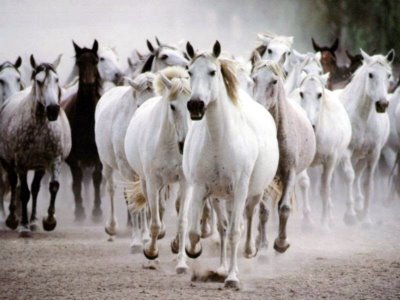
These horses can represent the 'core' of the concept of 'species range' or 'landscape conservation.'
Spatial patterns of migration. Genetic migration. The range in which a species' genetics allows it to adapt to changes in the environment of which it survives.
The light colored horses are the 'core' of the survival species while the grays are a 'range' of that species near the core; while the dark horses are the peripheral genetic variability. They are the survivors when all else fails for the core of the genetic composition for this species.
But.
What occurs when even the dark colored survivors are faced with elements in their survival range that compromise their genetic toughness?
More than likely, extinction.

Abstract
Compared with populations near the core of a species' range, edge populations tend to be characterized by low density and high temporal variation. Based on empirical studies quantifying this pattern, we show that effective population size (N e)could be 2 to 30 times greater near the core of the species' range than near the edge of the range.
Hence, the rate of genetic drift may be 2 to 30 times greater near the edge of the range. Despite these strong spatial patterns in N e, empirical findings indicate that peripheral populations sometimes have less but sometimes have more genetic diversity than core populations.
Our analysis indicates that this variation can be explained by uncertainty in spatial patterns of migration rates. Nevertheless, our analysis:(1) provides a framework or null hypothesis for empirically assessing how spatial patterns of migration or selection influence large-scales patial patterns of genetic diversity, (2)highlights the potential importance of contemporary processes, such as spatial patterns in N e (cf. historicalphenomena, such as range expansion) in the development and maintenance of large-scales patial patterns in genetic diversity, and (3) provides new context for understanding the conservation value and vulnerability of peripheral populations. The conservation of ecological/evolutionary processes requires understanding large scale spatial patterns of demographic and genetic processes such as that described here.